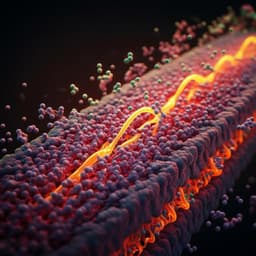
Medicine and Health
Barbed arrow-like structure membrane with ultra-high rectification coefficient enables ultra-fast, highly-sensitive lateral-flow assay of cTnI
J. Li, Y. Liu, et al.
Discover a groundbreaking advancement in cardiac troponin I detection with the introduction of the barbed arrow-like structure membrane (BAS Mem). This innovative approach enables incredibly fast and sensitive lateral-flow assays, achieving results in just 240 seconds. Researchers Juanhua Li, Yiren Liu, Tianyu Wu, Zihan Xiao, Jianhang Du, Hongrui Liang, Cuiping Zhou, and Jianhua Zhou have pioneered a technique that promises to enhance timely diagnosis of acute myocardial infarction.
~3 min • Beginner • English
Introduction
AMI requires rapid, accurate detection of cardiac injury markers to enable early diagnosis and intervention. Cardiac troponin I (cTnI) is the gold-standard biomarker for myocardial injury, but conventional nanogold LFA using fiber-based nitrocellulose membranes suffers from slow capillary flow, non-specific adsorption in porous matrices, high residual complexes off the test/control lines, and suboptimal signal-to-noise ratio. This work addresses the need for a faster, more sensitive hs-cTnI assay by introducing a barbed arrow-like structured membrane (BAS Mem) that rectifies liquid flow, accelerates transport to the T/C lines, reduces residual background, and improves analytical performance for point-of-care testing.
Literature Review
LFA is widely used for rapid diagnostics but is often limited by fiber-based chromatographic membranes that slow flow (<0.5 mm s−1), trap analytes, and increase background noise, degrading sensitivity and extending assay times to 15–30 min. Prior work on directional wetting and liquid diodes has shown that asymmetric micro/nanostructures can impart unidirectional spreading, yet achieving high rectification and integrating such structures into LFA has been challenging. High-sensitivity cTnI assays exist on centralized platforms, but few nanogold LFAs reach comparable LODs. Commercial nanogold cTnI strips typically require 15–30 min and have LODs orders of magnitude higher than clinical analyzers. This study leverages literature on capillarity, edge pinning, and directional transport to engineer a membrane with enhanced rectification and applies it to LFA to overcome existing limitations.
Methodology
Design and fabrication of BAS Mem: The BAS Mem comprises parallel, equidistant microchannels formed by interconnected barbed arrow-like grooves bounded by long-arc and short-arc sidewalls meeting at sharp corners. Key geometric parameters: short-arc angle α, long-arc angle β, minimum channel width W, sidewall height H, and inter-channel spacing S. Aluminum molds were laser-carved (UV-3S-SP; scan speed 400 mm s−1), PDMS masters were cast (10:1 A:B, degassed, cured at 80 °C for 40 min), and patterns were hot-embossed into polymer membranes (e.g., HDPE, 0.5 mm thick) at 150 °C under 0.3 tons. A hydrophilic surface coating was applied with tunable wettability. Variants on PMMA and PP were also produced.
Theory and simulation: Force balance on menisci was analyzed for forward (concave) and backward (convex) movement considering underside and sidewall contributions. Expressions for total forces Ftp (backward) and Fts (forward) were derived, predicting pinning at sharp corners in the backward direction and aided spreading forward. The rectification coefficient k = Ls/Lp was defined. ANSYS Fluent simulations visualized droplet expansion and pinning within single structure units and evaluated the effect of contact angle θ (34°, 56°, 70°) on flow directionality.
Membrane performance testing: Red ink droplets (10–30 µL) were dispensed to quantify forward/backward lengths (Ls, Lp), flow time over set distances, and average velocity. Contact angles were tuned via oxygen plasma to identify unidirectionality conditions (48° < θ < 64°). Batch-to-batch reproducibility, long-term hydrophilicity (up to 6 months), and protein non-specific adsorption were evaluated using FITC-BSA versus nitrocellulose (NC Mem). High-speed microscopy captured microchannel-scale forward spreading and backward pinning.
Mimic-strip transport and residuals: Mimic strips (sample pad + test membrane + absorbent pad) using BAS Mem or NC Mem transported nanogold-labeled antibody (Au-Ab). Time-lapse imaging and ImageJ quantification tracked color intensity over 300 s to estimate residuals on the membrane.
LFA strip construction: BAS Mem-based strips incorporated cellulose acetate (CA) fiber bands as T and C lines formed by drop-casting a CA slurry (acetone/DMF), inducing rapid fiber formation with added water, washing, and drying at 37 °C. EDC/NHS chemistry immobilized capture reagents: EDC (2.5% w/w) pre-activation, NHS (2.5% w/w in PBS pH 8.0) mixed with cTnI antibody (1 mg mL−1) for T line and with human IgG (1 mg mL−1) for C line; applied at 1.0 µL cm−2. Conjugate pads were loaded with Au-labeled antibodies (10 µL, 50 µg mL−1) and incubated 30 min at 37 °C. Components (sample pad, conjugate pad, BAS Mem with T/C lines, absorbent pad, backing) were assembled with ~2 mm overlaps into cassettes (75×20 mm).
Assay protocol and analysis: 60 µL of sample was applied; results read at 4 min. Valid outcomes: T+C positive; C only negative; no C invalid. Time to T/C stabilization was monitored. Calibration used PBS samples spanning cTnI concentrations from pg mL−1 to µg mL−1. LOD was determined by blank mean + 3×SD. Threshold and cut-off were derived via Q–Q plots and ROC analysis. Clinical testing involved 25 serum samples (10 normal, 15 suspected AMI), under IRB approval with consent. ImageJ and Origin were used for intensity quantification, ROC, AUC, and statistics.
Key Findings
- BAS Mem achieved ultra-high rectification of liquid flow with k = 14.5, 13.5× higher than nitrocellulose (NC Mem, k ≈ 1.02), the highest reported to date.
- Ultra-fast transport: average flow velocity 5.48 mm s−1 on BAS Mem vs 0.23 mm s−1 on NC Mem (~23× faster). Time to spread 20 mm was 4.0 s on BAS vs 78.0 s on NC (93.5% reduction).
- Unidirectionality condition: experimentally and via simulation, unidirectional flow occurred for contact angles 48° < θ < 64°; at θ=56° flow was unidirectional; θ=34° bidirectional; θ=70° limited; θ=130° static.
- Sample utilization: Only 3 µL was required to traverse T and C lines on BAS Mem vs 10 µL on NC Mem (~70% reduction in sample volume).
- Lower residuals: After 300 s in mimic strips with Au-Ab, residual color intensity on BAS Mem was ~48% lower than NC Mem, indicating reduced non-specific retention.
- LFA performance: Using BAS Mem reduced detection time by 73% versus NC-based strips; increased detection signal by 37.9% and decreased background noise by 67.7%, yielding SNR = 19.3 (4.3× higher than NC strips).
- Quantitation: Linear response (R² = 0.994), CV < 5.7%, LOD = 1.97 pg mL−1 (0.00197 ng mL−1). Threshold for mimic samples = 6.602 (intensity units). T line stabilized at 240 s.
- Clinical validation (n=25): specificity 100% (10/10), sensitivity 93.3% (14/15), AUC = 0.953; cut-off = 6.235; CV < 5.6%; 0.99 quantile of cTnI concentration cited at 0.04 ng mL−1.
- Material/process robustness: Fabrication on HDPE, PMMA, PP; consistent performance across batches; hydrophilicity retained after 6 months.
- Larger probe compatibility: With 500 nm nanospheres, BAS strips increased T-line signal by 106.8% and reduced noise by 79.0% vs NC (SNR 11.7, 9.8× higher). With 1 µm probes, BAS enabled qualitative detection while NC failed; BAS increased signal by 541.8% and reduced noise by 84.7% (SNR 19.2, 32× higher).
Discussion
The BAS Mem addresses key limitations of conventional fiber-based LFA membranes by rectifying and accelerating surface liquid transport while minimizing non-specific retention. Sidewall-induced forces at sharp corners pin backward menisci and assist forward motion, creating strong unidirectionality and rapid delivery of complexes to T/C lines. Despite high overall transport speed, flow slows locally at the T line, preserving sufficient residence time for antigen–antibody binding. Consequently, detection time is shortened to 4 minutes without sacrificing binding efficiency, and signal-to-noise ratio is markedly improved through reduced off-line residues. The very low LOD (1.97 pg mL−1) approaches that of clinical analyzers while retaining the simplicity of nanogold LFA. Clinical testing demonstrates high specificity and sensitivity with an AUC near 1, indicating reliable discrimination of AMI cases. The surface microchannel approach broadens compatibility with larger biomarker targets and larger nanoparticle probes that are challenging for porous nitrocellulose, suggesting expanded applicability across diagnostics. The underlying fluidic mechanism and structure–wettability design principles also offer a generalizable strategy for microfluidic control in other applications.
Conclusion
This work introduces a barbed arrow-like structured membrane that achieves record-high flow rectification (k=14.5) and ~23× faster capillary transport, enabling an ultra-fast, highly sensitive nanogold LFA for cTnI. BAS Mem-based strips deliver results in 4 minutes with an LOD of 1.97 pg mL−1 and strong clinical performance (100% specificity, 93.3% sensitivity; AUC 0.953). The membrane reduces sample volume requirements, minimizes residuals, and increases SNR, and is compatible with larger nanoprobes beyond the capabilities of traditional nitrocellulose. These advances can facilitate earlier AMI warning and broader point-of-care use. Future work should focus on large-scale manufacturing and quality control of BAS Mem, extended clinical validation across diverse populations and settings, multiplexed biomarker panels, long-term stability in varying environmental conditions, and integration with portable readers for quantitative reporting.
Limitations
- Clinical validation used a relatively small cohort (n=25) and a single clinical site; broader, multi-center studies are needed to confirm diagnostic performance and cut-offs.
- The demonstration focuses on cTnI; generalization to other biomarkers requires additional assay optimization and validation.
- Unidirectional performance depends on maintaining surface wettability within 48°–64°; hydrophilic coatings and environmental aging may affect performance beyond the tested six-month period.
- Many benchmarks used model solutions (red ink, PBS) and controlled conditions; complex clinical matrices and variable hematocrit in whole blood could introduce additional variability.
- Detailed manufacturing reproducibility and tolerance analyses (e.g., microfeature dimensions across large-area rolls) and cost at scale, while discussed qualitatively, require further quantitative assessment.
Related Publications
Explore these studies to deepen your understanding of the subject.







